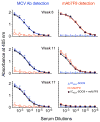Combining Active Immunization with Monoclonal Antibody Therapy To Facilitate Early Initiation of a Long-Acting Anti-Methamphetamine Antibody Response
- PMID: 25973614
- PMCID: PMC4601636
- DOI: 10.1021/acs.jmedchem.5b00220
Combining Active Immunization with Monoclonal Antibody Therapy To Facilitate Early Initiation of a Long-Acting Anti-Methamphetamine Antibody Response
Abstract
We hypothesized that an anti-METH mAb could be used in combination with a METH-conjugate vaccine (MCV) to safely improve the overall quality and magnitude of the anti-METH immune response. The benefits would include immediate onset of action (from the mAb), timely increases in the immune responses (from the combined therapy) and duration of antibody response that could last for months (from the MCV). A novel METH-like hapten (METH-SSOO9) was synthesized and then conjugated to immunocyanin monomers of keyhole limpet hemocyanin (IC(KLH)) to create the MCV ICKLH-SOO9. The vaccine, in combination with previously discovered anti-METH mAb7F9, was then tested in rats for safety and potential efficacy. The combination antibody therapy allowed safe achievement of an early high anti-METH antibody response, which persisted throughout the study. Indeed, even after 4 months the METH vaccine antibodies still had the capacity to significantly reduce METH brain concentrations resulting from a 0.56 mg/kg METH dose.
Figures









Similar articles
-
Vaccination protects rats from methamphetamine-induced impairment of behavioral responding for food.Vaccine. 2013 Sep 23;31(41):4596-602. doi: 10.1016/j.vaccine.2013.07.038. Epub 2013 Jul 29. Vaccine. 2013. PMID: 23906885 Free PMC article.
-
Generation of anti-(+)methamphetamine antibodies is not impeded by (+)methamphetamine administration during active immunization of rats.Int Immunopharmacol. 2001 Feb;1(2):329-38. doi: 10.1016/s1567-5769(00)00019-9. Int Immunopharmacol. 2001. PMID: 11360933
-
Treatment of rats with an anti-(+)-methamphetamine monoclonal antibody shortens the duration of action of repeated (+)-methamphetamine challenges over a one month period.Vaccine. 2014 Oct 29;32(47):6213-9. doi: 10.1016/j.vaccine.2014.09.025. Epub 2014 Sep 22. Vaccine. 2014. PMID: 25252196 Free PMC article.
-
Vaccine development against methamphetamine drug addiction.Expert Rev Vaccines. 2020 Dec;19(12):1105-1114. doi: 10.1080/14760584.2020.1857738. Epub 2020 Dec 10. Expert Rev Vaccines. 2020. PMID: 33251859 Review.
-
Development of active and passive human vaccines to treat methamphetamine addiction.Hum Vaccin. 2009 Apr;5(4):206-13. doi: 10.4161/hv.5.4.7456. Epub 2009 Apr 20. Hum Vaccin. 2009. PMID: 19276653 Free PMC article. Review.
Cited by
-
Monoclonal Antibodies for Combating Synthetic Opioid Intoxication.J Am Chem Soc. 2019 Jul 3;141(26):10489-10503. doi: 10.1021/jacs.9b04872. Epub 2019 Jun 25. J Am Chem Soc. 2019. PMID: 31187995 Free PMC article.
-
The Main Molecular Mechanisms Underlying Methamphetamine- Induced Neurotoxicity and Implications for Pharmacological Treatment.Front Mol Neurosci. 2018 Jun 4;11:186. doi: 10.3389/fnmol.2018.00186. eCollection 2018. Front Mol Neurosci. 2018. PMID: 29915529 Free PMC article. Review.
-
The cross-talk of HIV-1 Tat and methamphetamine in HIV-associated neurocognitive disorders.Front Microbiol. 2015 Oct 23;6:1164. doi: 10.3389/fmicb.2015.01164. eCollection 2015. Front Microbiol. 2015. PMID: 26557111 Free PMC article. Review.
-
Broadly Neutralizing Synthetic Cannabinoid Vaccines.JACS Au. 2020 Dec 15;1(1):31-40. doi: 10.1021/jacsau.0c00057. eCollection 2021 Jan 25. JACS Au. 2020. PMID: 34467269 Free PMC article.
-
Biologics to treat substance use disorders: Current status and new directions.Hum Vaccin Immunother. 2016 Dec;12(12):3005-3019. doi: 10.1080/21645515.2016.1212785. Epub 2016 Jul 21. Hum Vaccin Immunother. 2016. PMID: 27441896 Free PMC article. Review.
References
Publication types
MeSH terms
Substances
Grants and funding
LinkOut - more resources
Full Text Sources
Other Literature Sources
Medical

